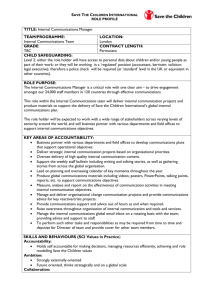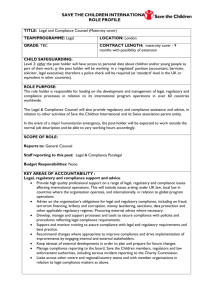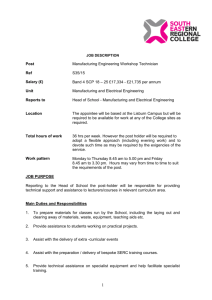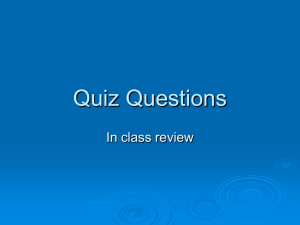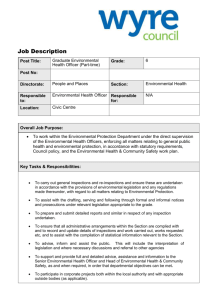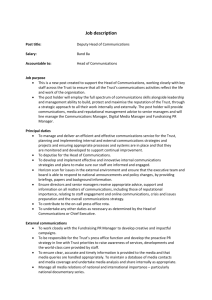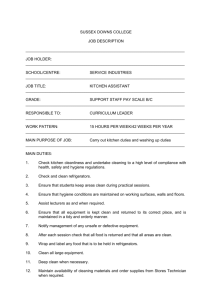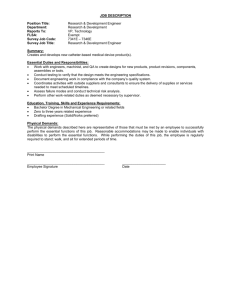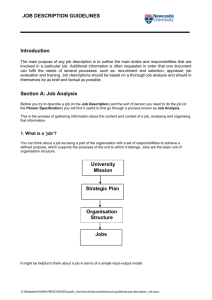Job Description and Person Specification Guidelines
advertisement
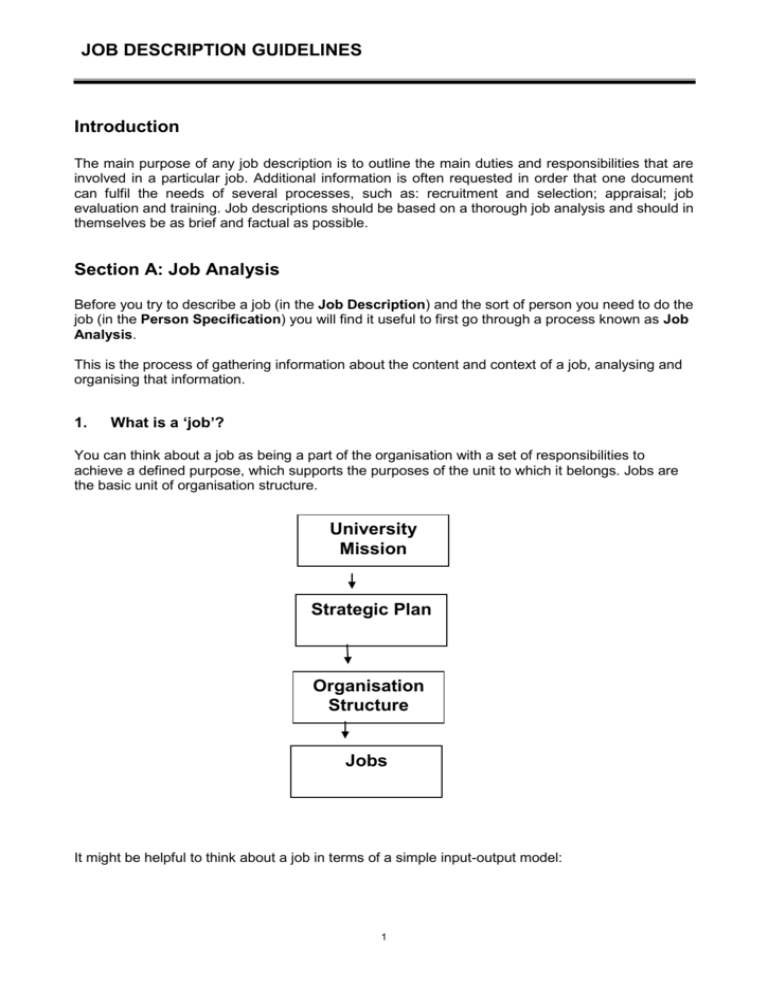
JOB DESCRIPTION GUIDELINES Introduction The main purpose of any job description is to outline the main duties and responsibilities that are involved in a particular job. Additional information is often requested in order that one document can fulfil the needs of several processes, such as: recruitment and selection; appraisal; job evaluation and training. Job descriptions should be based on a thorough job analysis and should in themselves be as brief and factual as possible. Section A: Job Analysis Before you try to describe a job (in the Job Description) and the sort of person you need to do the job (in the Person Specification) you will find it useful to first go through a process known as Job Analysis. This is the process of gathering information about the content and context of a job, analysing and organising that information. 1. What is a ‘job’? You can think about a job as being a part of the organisation with a set of responsibilities to achieve a defined purpose, which supports the purposes of the unit to which it belongs. Jobs are the basic unit of organisation structure. University Mission Strategic Plan Organisation Structure Jobs It might be helpful to think about a job in terms of a simple input-output model: 1 JOB DESCRIPTION GUIDELINES PROCESSES INPUTS Knowledge Skills Experience Behaviours 2. OUTPUTS Job responsibilities / tasks What the job is there to achieve. What is done Why it is done. How to conduct job analysis There are several ways of approaching this task. The following approaches might be helpful to you: Review existing documents, including existing job descriptions, structure charts and business plans. Discuss with the current or previous job holder(s). Discuss with Human Resources. Your local HR team can provide support in this area. They know the sort of information that is needed and, being a step removed from the situation, may be able to spot gaps or suggest improvements. They may also be able to provide you with examples that might save you some work. Before capturing the information in the job description (which includes the person specification), you might find it particularly useful to consider the following. 3. Results Analysis It is important to be clear about what the job exists to achieve – the ‘outputs’ of the role, often called ‘Key Results’. From these, you can work back to think about what has to be done to achieve those results (the ‘process’ in our simple job model) and what package of knowledge, skills, experience and behaviours this will demand (the ‘inputs’ in our model). Once you have established the key outputs, you can also think about what you would look for to establish how well the output is being achieved, i.e. the performance indicators for the job. You don’t need to know the performance standard at this stage, but you should be able to identify the sorts of evidence you would look for to assess how well the job is being done. Examples: Job Key Result Areas Performance Indicators Secretary Document Preparation Accuracy of documents Speed of preparation Presentation of documents Technician Fault finding Equipment down-time Speed of response 2 JOB DESCRIPTION GUIDELINES Kitchen Assistant Serving meals Customer feedback Portion control Appendix 2 is appended for you to use to capture information on Results and Performance Indicators. 4. Situational Analysis It will be useful to consider the different situations in which the job operates. This context will help you to determine the type of person you will need to do the job effectively. First, think about the different duties involved in the post and whether they are done in situations which are: Individual Situations Situations in which the jobholder takes independent action or performs on their own. Dialogues Situations where the jobholder is dealing with one other person (either internal or external to their own team). Examples might include advising, negotiating, coaching, answering, supervising. Group Conversations Situations in which the job holder must relate to several people. This may include all types of group situation such as taking part in meetings, presenting, training or teaching a group. Critical Incidents It can also be useful to analyse situations which are critical to the success of the role. What are the ‘high risk’ situations during which a strong performer really shines or a less effective performer is left wanting. What are the situations when there is no room for error? Appendix 3 is provided to help you capture this information. 3 JOB DESCRIPTION GUIDELINES Section B: Guidance on Writing Effective Job Descriptions The headings under which a job description should be written and notes for guidance on completing each section are set out below: 1. Job Details 1.1 Job Title The job title should be brief and accurately describe the job, whilst retaining consistency with University norms. It should not include the Organisation Unit name. For example state “School Administrator” and not “School Administrator in the Institute of XYZ”. Any new job title must be checked with your local HR team. 1.2 Academic/Service Unit The name of the school e.g. School of Dental Sciences or the name of the Professional Support Service e.g. Estates Support Services 1.3 Faculty/Professional Support Services (PSS) The name of the Faculty e.g. Medical Sciences or PSS 1.4 Position Number This number is unique to the job and is allocated by HR when the post is created. 1.5 Effective Date The date that the job description is effective from. 1.6 Grade The grade of the job, as confirmed by HR. 1.7 Vacancy Ref To be used for recruitment purposes only and as allocated by HR. 2. Main Purpose of the Job This should be an accurate and concise statement of the contribution the job makes to the University. It should not exceed a paragraph in length, and is normally capable of being contained within one sentence. The purpose does not include a detailed list of how the job is done, or a list of problems, tasks and activities. Nor is it a summary of the duties and responsibilities or a description of the Academic/Service Unit. You may find it easier to write the purpose statement by answering one of the following questions: What is it that the job is intended to achieve? What would not get done if the job did not exist? What is the contribution that the job makes to the University? 4 JOB DESCRIPTION GUIDELINES Examples: The purpose of a Director of Information Technology might read: Develop and implement an Information Technology Strategy for the organisation that reflects and supports the current and future needs of the Organisation. The purpose of a Finance Assistant might read: To maintain all operational aspects of the school’s accounts to ensure school expenditure and income is accurately processed and reported upon. When preparing the job description it may be better to defer writing down the purpose of the job until the main duties and responsibilities have been analysed and described. 3. Main Duties and Responsibilities The steps required to define the main duties and responsibilities of the job are as follows. The information you gain from a ‘Results Analysis’ described in Section A will help you describe the main duties and responsibilities. 3.1 Firstly, identify and list the tasks that are carried out. No attempt should be made to describe how they are carried out but some indication should be given as to the purpose of each task. 3.2 Analyse the initial list of tasks and, so far as possible, simplify the list by grouping related tasks together so that no more than say, seven or eight main areas of responsibility remain. 3.3 Decide on the order in which the main responsibilities should be described. Perhaps the most effective order is to list the most important duties first. An alternative is to adopt a more chronological order; this can be useful when jobs are based around a core process or calendar of events. 3.4 A typical sentence describing a task should start with an action verb and use verbs which express the actual responsibility, for example: to recommend; to ensure that; to collaborate; to prepare; to supervise. A list of action verbs is attached. Complete the sentence by stating why that action is carried out. This indicates the purpose of the task and can lead to setting targets or performance standards more easily. A useful format for constructing a job responsibility is: ”What is done” ”To what” ”To achieve what result” 3.5 Examples are: What is done To supervise To what the team To undertake equipment maintenance 5 To achieve what result so that staff have the motivation and training to deliver the required levels of performance in order to ensure that JOB DESCRIPTION GUIDELINES To design 3.6 To design degree courses for undergraduate students training courses To produce the management accounts equipment is kept in a safe working condition. to meet the school’s teaching objectives in order to produce quality training events that meet the University’s training strategy in order to provide accurate and timely management information Having written down the main duties and responsibilities, amplify each sentence appropriately using precise terminology and examples if necessary. An example of expanding the first of the above statements regarding supervision could include: recruits and selects team members, sets performance objectives, agrees training and development plans and handles any performance issues. Managers should not feel it necessary to amplify every sentence. However for certain elements further detail will provide a fuller picture of the main duties. 3.7 Where acronyms are to be used please ensure the first instance is stated in full e.g. Performance Related Pay (PRP). For the more common acronyms e.g. BTEC, RSA this will not be required. 4. Dimensions This section contains the factual, quantitative and qualitative information that will help to describe the context in which the job operates. Any information provided in this section should correspond to statements in the previous section. Typical job dimensions are given below: 4.1 Staff Number and profile of staff supervised including whether full time, part time, voluntary or other. This can include for example, supervision of a team of external contractors. 4.2 Financial Budgets managed, including grant monies, discretionary funds and monies generated. Wherever possible please provide the annualised amount or time period for which the funds are allocated to. 4.3 Research Number and amount of research grants managed or coordinated annually. 4.4 Teaching Number and type of courses managed or delivered annually. 4.5 Customer Number and type of external and internal customers who are key to the performance of the main duties and responsibilities. 6 JOB DESCRIPTION GUIDELINES 4.6 Administrative Management or attendance on committees which link to the main duties and responsibilities and are key to the delivery of objectives. 4.7 Other 5. Special Features The purpose of this section is to provide the opportunity to identify aspects of the job that are important and have a significant impact on the job. There should be some comments on the following areas: 5.1 Planning and Organising This should describe the requirement for planning and organising within the job. It may be a direct requirement to plan and organise the job holder’s own workload, that of other people, or the allocation and use of resources. Some points useful to include are: - how does work come to the job holder? - does he/she plan to deal with it? - to what extent can the job holder plan ahead? - what timescales are planned over e.g. daily/monthly? 5.2 Decision Making Describe the job’s role in decision making. It would be particularly useful to include: - examples of typical decisions made independently or are involved with - the nature of the role in decisions e.g. formal sign off, recommending, advising - contributions made by others to decisions - what guidelines are in place to support decisions? 5.3 Internal and External Relationships In this section identify and describe the most significant internal and external relationships that are involved in the job, ensuring that the content and nature of the relationship is clear. Do not describe every relationship, only those that play an important part in getting the job done, e.g. Negotiating contracts with purchasers Developing services with customers Managing staff 5.4 Other Relevant Information There may be other relevant information such as: 7 JOB DESCRIPTION GUIDELINES A brief description of the types of specialist equipment used and the frequency and nature of use e.g. basic operation, installation, maintenance etc. The knowledge, skills and experience needed to use this equipment to the required standard should be described in the appropriate section (see Section xx below). Operating in a highly technical or particularly complex field. Operating in a highly complex external market place. Involvement in political/public relations issues. The physical effort and/or strain on the job holder in performing the job to the required standards. Unfavourable environmental conditions to which the job holder is necessarily exposed in order to perform the job. 6. Organisation Chart An organisation chart should be attached showing the reporting relationships relevant to the job. Ideally the whole unit should be shown, where practicable, with clear identification of the appropriate team. Where this is not possible the chart should show the following: The title of the person to whom the job reports The titles of all other jobs reporting to that person The titles of all jobs reporting to the job holder Which job the job description refers to Dotted lines where there is a “functional” reporting structure The organisation chart should not include names of employees, staff categories or grades. Additional notes can be used, for example, to explain the nature of reporting lines and supervision. 7. Person Specification This section must be completed to show the key knowledge, skills, experience and behaviours required to perform the role effectively. This information is not just used for recruitment and selection purposes – it is also needed for other HR processes such as job evaluation and reorganisations. It should be used for: identifying the minimum (essential) qualities necessary for the job to be performed to an adequate standard identifying the ideal (desirable) qualities for outstanding performance in the post forming the basis of a job advertisement enabling prospective applicants to self-select by assessing themselves against the requirements for the post 8 JOB DESCRIPTION GUIDELINES ensuring that rigorous criteria are consistently applied in the shortlisting and selection of employees so that they are compared against the requirements of the post and not against one another, thus ensuring equality of opportunity and providing a defence against possible claims providing a basis for determining selection methods providing a basis for determining screening questions and/or core interview questions The person specification should relate to the job description and the criteria should be clear, specific, and measurable. The essential qualities should represent the minimum requirements without which a candidate simply would be unable to do the job properly. It therefore follows that if a candidate does not meet any one of the essential requirements of the post, they must be rejected. Please note also that the University has a legal obligation to redeploy current employees who are under threat of redundancy or whose fixed term contracts are coming to an end (redeployees), provided that they meet the essential (not desirable) criteria on the person specification (allowing for any reasonable adjustments that may be necessary under the Equality Act (2010). so it is important that the essential criteria are carefully defined. Desirable qualities are those which will enhance performance in the job but which are not fundamental to successful performance. The desirable criteria identify the ‘ideal’ person for the post and form the basis for selection at the interview/assessment stage. It is important to ensure that the criteria on the person specification can be justified and that they are not indirectly discriminatory. For example ‘energetic’ or ‘in good health’ could discriminate against certain applicants with disabilities, who could actually perform the duties of the post perfectly well, or specifying only UK qualifications could rule out good applicants who obtained their qualifications overseas etc. To comply with laws on Age Discrimination it is imperative that care is taken when specifying a requirement for previous experience. Try to avoid any statement that indirectly refers to age e.g. asking for 10 years’ experience unless the statement is justifiable in objective terms. Alternatively, focus on the competencies and type of experiences required. An indication may be made as to the length of time it may take to obtain the experience. For example: You must have relevant experience of working with managers on strategic management, performance management, employee relations, resourcing and staff management/development issues. You will need a pro-active, participative and flexible approach to deliver a high level of service to the business units, with experience of managing and championing change and persuading and influencing key players. For further guidance and information contact your Human Resources team. 8. Behaviours (Success Factors) Success Factors describe the behaviours which lead to successful performance in the job. Use the job analysis information to determine the 3-5 core success factors. Further guidance is available from your Human Resources Team and at www.ncl.ac.uk/hr/recruitment/successfactors.php 9. Signatures Job descriptions should always be reviewed and discussed with any current job holder/holders. 9 JOB DESCRIPTION GUIDELINES To ensure that the job description is acceptable to all interested parties, the last page of the document is to be signed by the job holder, (or where there are multiple job holders, by one of the job holders), the Manager and Academic Service/Unit. It is then reviewed by the relevant Human Resources Team to ensure it is of an appropriate standard. 10 JOB DESCRIPTION GUIDELINES Appendix 1 ACTION VERBS Accumulate Achieve Advise Analyse Appraise Approve Ascertain Assess Assign Assist Assure Authorise Budget Check Compile Complete Follow-up Forecast Formulate Fulfil Furnish Gather Give Help Hire Identify Implement Improve Inform Interview Inspect Receive Recruit Recommend Reject Report Represent Review Serve Service Set Specify Standardise Store Structure Study Submit Supervise Supply Survey Conduct Consult Contact Contribute Issue Keep Take Train Control Co-ordinate Counsel Limit Undertake Design Determine Develop Dictate Direct Distribute Ensure Establish Evaluate Examine Uphold Maintain Meet Motivate Verify Write Participate Perform Plan Prepare Present Process Produce Propose Provide 11 JOB DESCRIPTION GUIDELINES Appendix 2 Results Analysis Job Title Academic/Service Unit Key Result Areas Performance Indicators What outputs are expected to be achieved. What factors will be used to evaluate performance in the Key Result Areas? 12 JOB DESCRIPTION GUIDELINES Appendix 3 Situational Analysis What types of activities involve working in Individual Situations? What types of activities involve working in Dialogue Situations? What types of activities involve working in Group Situations? Critical Incidents Situations in which the job holder is vulnerable. For example, situations which demand extreme effort or which reflect especially good or poor performance. High risk events which are critical to job success. 13
